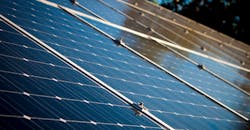Americans have seen some interesting changes in the Oval Office to say the least, but one thing that has not changed much is our consumption of renewable energy. Solar and wind energy made up 47% of new electric capacity last year, and the renewables sector has grown steadily since the mid-2000s.
Part of the reasoning behind this is cost. Installation costs for solar infrastructure have fallen 70% since 2006. Many homeowners have also done away with their electricity bill, thanks to net metering. But while the technology has become more accessible to homeowners and enterprises alike, there is a hidden cost to solar energy that lies in hefty government subsidies.
The Most Efficient Solar Panel
Solar panel technology has advanced considerably in the last decade. Solar panels are divided into three main technologies: monocrystalline, polycrystalline, and thin-film. Each type of panel utilizes different technology to harness the sun’s rays and has a different range of applications.
Monocrystalline (mono) panels are the most efficient solar panel in terms of power output relative to panel size. These panels have the highest efficiency rating on the market at 15-22%, and therefore require the least amount of space. Mono panels also have the longest lifespan (25 years or more), due to the high-purity silicon used during manufacturing. Mono panels have the highest upfront costs of all solar technologies.
Polycrystalline (poly) solar panels are manufactured using several silicon crystals, and typically carry an efficiency rating of 13-17%. Poly panels require more space to match the power output of mono panels due to a lower silicon purity. However, manufacturing poly panels is a much simpler process, making the technology less expensive. Poly panels also have a lifespan of about 25 years, and over time may prove to be the most cost-effective.
Thin film (TF) is a newer technology made possible by depositing a photovoltaic material onto a surface. The photovoltaic materials used are not as energy-efficient as crystallin silicon, but still get an energy efficiency rating of 7-13%. TF panels require much more space to produce a commercially significant wattage, limiting the potential for residential installations. TF panels also lack the durability of mono or poly panels. Still, TP panels are much cheaper to produce than mono or poly panels, and can even be made flexible, offering solar options in situations previously thought impractical.
The ROI
Calculating ROI depends on several factors, such as the plot available for infrastructure, location, and amount of solar radiation per year. If roof space is limited, mono panels could offer consumers the most output. If a location is large enough to accommodate poly panels, this type of infrastructure could produce the same output as the mono panels, at a savings of 10 to 20%.
The cost of solar panels is calculated using dollars per watt. In 2018, the average installation cost for homeowners was between $2.87 and $3.85 per watt. Before tax credits, the gross cost of solar panels averages to $16,800. Assuming 5 kilowatts (kW) per household, solar panels cost from $10,045 to $13,475 after tax credits are applied.
Solar incentives and rebates also provide an opportunity for households to take advantage of solar energy. For example, the Solar Investment Tax Credit (ITC) allows homeowners to receive a 30% tax credit for the purchase and installation of solar panels through 2019.
The long-term value of a solar installation will largely depend on how it is financed. Buying the system upfront yields the best ROI, but even a $0-down solar loan could provide saving of $10,000 or more. Solar leases or power purchase agreements (PPAs) offer much lower savings—between 10 and 30% of the average household’s electric bill.
On average, a solar panel system pays for itself within eight years. If a consumer purchased mono or poly panels with a 25-year life span, consumers could yield 17 years of cost savings on electric expenses.
A solar savings study was conducted in Southern California using a 1,500-sq.-ft., two-bedroom house with a monthly utility cost of $152 for 9,125 kWh. The best offers predicted if the household leased the solar panels, it could save $5,810 over 20 years. But if the solar panel installation was bought outright, the household could save up to $22,287 over 20 years. Even if the solar panels were loaned, the household could still save $18,561 over 20 years.
Net metering is another way solar panels can add value to a household. Net metering allows households using solar power to sell excess power back to the grid. Residential customers can therefore offset electricity usage during times when solar panels are not capturing energy. Net meeting regulations, however, differ from area to area throughout the U.S.
Homeowners looking to purchase solar panels in the near future should be aware of a new 30% tariff now affecting imported solar panels. Residential installation costs are only expected to increase by approximately 3%, as most of the cost is due to labor. Utility scale installations could see costs increase as much as 10%.
The Effect on the Environment
Though solar energy can provide cost savings for homeowners, no energy infrastructure is without its impact on the environment. Solar energy is no different. Large-scale solar farms may influence land degradation and habitat loss. Utility-scale solar facilities require large plots, and could interfere with wilderness areas, mineral production, military uses, and protected natural environments. And unlike wind farms, solar facilities have trouble sharing the land for agricultural uses.
Some utility solar systems use steam plants to generate electricity and use water for cooling. Because solar farms are often very dry climates, any increase in water demand may threaten local resources. Chemicals used at the solar facilities—including dust suppressants, dielectric fluids, and herbicides—could also end up contaminating the groundwater. Additionally, if solar farms are near protected wilderness areas, the waste produced at these facilities could result in large-scale pollution.
Lastly, the effects of using TF solar panels are only beginning to be investigated. The technology is developed using several toxic substances, including gallium arsenide, copper-indium-gallium-diselenide, and cadmium-telluride. If these solar panels are damaged or disposed of improperly, it could pose a serious health risk for anyone near the dump site. TF panels also often contain cadmium, an identified carcinogen.
The Truth Behind Solar Subsidies
The cost of solar infrastructure and installations has fallen largely due to government subsidies. In fact, some say solar energy could not survive at all without massive government subsidies. In terms of production, solar energy has received ten times the subsidies all other forms of energy. Subsidies for solar directly affect the production of electricity, directly affecting cost and pricing. Between 2010 and 2016, subsidies for solar energy ranged from 10¢ to 88¢ per kWh, while subsidies for coal, natural gas, and nuclear were from 0.05¢ to 0.2¢.
These subsidies incentivize solar panels, but end up increasing the cost of the electricity they generate. This cost is transferred directly to the ratepayers via utility bills. Moreover, customers involved in net metering are often paid inflated prices for excess power produced. Ratepayers end up funding the production of already heavily subsidized solar installations, a phenomenon which actually makes the adoption of renewable energy costlier.
The Real Racket
Though experts have warned against continuing to subsidize renewable energy, the subsidies persist. Worse yet, 80% of solar panel infrastructure in 2017 was imported from Asia-based manufacturers, meaning these funds aren’t even supporting American companies. Taxpayer-funded subsidies are funding foreign, specifically Asian, manufacturing. The new 30% tariff on foreign solar energy services, however, may offer a temporary solution.
The Final Word
Solar energy can provide consumers with significant savings on electricity. If adequate measures are taken to minimize its effects on the environment, the technology could prove to be a strong alternative to fossil fuels and wind power.
The subsidies given to solar energy, however, are unsustainable. It has caused the cost of solar energy to artificially rise, and has driven business to foreign manufacturers to save on cost in the short-term. We must begin thinking about the long-term consequences of our actions to ensure a foundation for a sustainable, planet-friendly energy sector that healthily supports both our national and the global economies.
About the Author
Cabe Atwell
Technology Editor, Electronic Design
Cabe is a Technology Editor for Electronic Design.
Engineer, Machinist, Maker, Writer. A graduate Electrical Engineer actively plying his expertise in the industry and at his company, Gunhead. When not designing/building, he creates a steady torrent of projects and content in the media world. Many of his projects and articles are online at element14 & SolidSmack, industry-focused work at EETimes & EDN, and offbeat articles at Make Magazine. Currently, you can find him hosting webinars and contributing to Electronic Design and Machine Design.
Cabe is an electrical engineer, design consultant and author with 25 years’ experience. His most recent book is “Essential 555 IC: Design, Configure, and Create Clever Circuits”
Cabe writes the Engineering on Friday blog on Electronic Design.


